No products in the cart.
Great news! The Canada Post strike is over! We’re resuming deliveries to Canada!
Excellente nouvelle ! La grève de Postes Canada est terminée ! Nous reprenons les livraisons vers le Canada !
Great news! The Canada Post strike is over! We’re resuming deliveries to Canada!
Excellente nouvelle ! La grève de Postes Canada est terminée ! Nous reprenons les livraisons vers le Canada !
[category_image]
Almagel A oral suspension in 10 ml sachets 20 pcs.
$26.44
Almagel A – antacid with local anesthetic effect. Relieves heartburn, pain, and discomfort while protecting the stomach lining.
Category: Gastrointestinal tract and liver
Brand: Teva
Pharmacological properties
Pharmacodynamics. Almagel A is a balanced combination of aluminum hydroxide and magnesium hydroxide in combination with sorbitol. Almagel A exhibits a moderate antacid effect when used in the recommended single and daily doses within 40-60 minutes after a meal.
Aluminum hydroxide neutralizes the increased secretion of hydrochloric acid and reduces the activity of pepsin in the stomach, forming aluminum chloride. Under the influence of the alkaline environment of the intestine, the latter is converted into alkaline aluminum salts, which are almost not absorbed and slightly change the concentration of aluminum salts in the blood with prolonged use of Almagel A. On the other hand, aluminum hydroxide has the property of changing the concentration of phosphates, binding phosphate ions in the intestine and thus limiting their absorption.
Aluminum-containing antacids, including Almagel A, also have a known cytoprotective effect on the gastric mucosa, associated with the activation of prostaglandin synthesis. Thus, the resistance of the mucosa increases, protecting it from inflammatory-necrotic and erosive-hemorrhagic changes caused by irritating and ulcerogenic agents, such as acetylsalicylic acid, nonsteroidal anti-inflammatory drugs, ethyl alcohol.
Magnesium hydroxide also neutralizes hydrochloric acid in the stomach, turning into magnesium chloride, which has a slight laxative effect.
Benzocaine has a local analgesic effect in the presence of severe pain.
Sorbitol has a weak carminative and moderate choleretic and laxative effect. Such effects compensate for the tendency to constipation under the influence of aluminum hydroxide in most patients.
The drug does not lead to the development of alkalosis and the formation of carbon dioxide (CO 2) in the stomach.
Pharmacokinetics. Aluminum salts are absorbed to a small extent in the intestine. Magnesium ions are absorbed only by 10% and their concentration in the blood almost does not change. The duration of action depends on the rate of gastric emptying. When used on an empty stomach, the action lasts 20-60 minutes.
Benzocaine is absorbed in minimal amounts and has virtually no systemic effect on the body. Its local anesthetic effect occurs 1-2 minutes after application of the suspension.
Indication
Short-term symptomatic treatment of inflammatory and erosive lesions accompanied by heartburn, discomfort, pain, nausea, vomiting; in acute or chronic inflammatory processes or other disorders of the mucous membranes of the esophagus, stomach or duodenum.
Application
Almagel should be used for the treatment of adults.
Before use, the suspension must be thoroughly homogenized by shaking the bottle or kneading the sachet. The drug should not be diluted or washed down. The required amount of the drug from the bottle is measured using the dosing spoon included in the kit. When using the drug in sachets, the following recommendations must be followed: hold the sachet vertically, cut or tear off one of the corners at the marked place. Pour the contents of the sachet through the opening of the sachet into a spoon or directly into the oral cavity.
Doses. Use 5-10 ml (1-2 measuring spoons) 3-4 times a day or 1 sachet 3-4 times a day 10-15 minutes before meals.
If the drug is prescribed in a single dose of 5 ml, it is recommended to use Almagel A in vials, since this type of packaging includes a dosing spoon, which makes it possible to accurately measure the required volume of the drug.
The duration of treatment with Almagel A should not exceed 7 days, then, as prescribed by a doctor, treatment with Almagel can be continued.
Children. The drug should not be prescribed to children, given the risk of developing methemoglobinemia.
Contraindication
The medicine should not be prescribed to children regardless of age, as well as to pregnant and breastfeeding women due to the benzocaine content.
Almagel A is contraindicated for use in case of hypersensitivity to any active and/or auxiliary substances that are part of the drug; hypersensitivity to anesthetics; chronic constipation; chronic diarrhea; severe abdominal pain of unspecified genesis, suspected acute appendicitis; Alzheimer’s disease; severe forms of renal failure (due to the risk of hypermagnesemia and aluminum intoxication); hypophosphatemia.
Side effects
When using the drug in recommended doses, side effects rarely occur.
On the part of the digestive system: constipation (results after reducing the dose), nausea, vomiting, stomach spasm, change in taste sensations.
Immune system disorders: hypersensitivity reactions, including skin rash, itching, urticaria, angioedema and anaphylactic reactions.
Metabolic and nutritional disorders: hypermagnesemia, hyperaluminemia, hypophosphatemia.
In patients with renal failure and patients on dialysis, prolonged use of aluminum and magnesium salts in high doses can lead to the development of encephalopathy, dementia, microcytic anemia or worsen the course of dialysis-induced osteomalacia, and due to the development of hypophosphatemia, lead to increased bone resorption processes and the occurrence of hypercalciuria with an increased risk of osteomalacia.
Special instructions
The drug is not recommended for use in patients with metabolic alkalosis, liver cirrhosis, severe heart failure, ulcerative colitis, diverticulosis, colostomy and ileostomy (increased risk of water and electrolyte imbalance), acute hemorrhoids, and renal failure.
Patients should be advised to consult a doctor in the following cases: weight loss; difficulty swallowing or persistent abdominal discomfort; new or worsening digestive disorders; renal failure.
Aluminum hydroxide can cause constipation, and an overdose of magnesium salts can lead to intestinal hypokinesia; the use of high doses of the drug can cause or exacerbate mechanical and dynamic intestinal obstruction in high-risk patients, such as patients with renal failure or the elderly.
When treating patients with renal failure or people on permanent hemodialysis, the presence of aluminum and magnesium in the drug should be taken into account (there is a risk of encephalopathy, dementia, microcytic anemia or may worsen osteomalacia caused by dialysis).
Aluminum hydroxide may be dangerous when used in patients with porphyria on hemodialysis. Prolonged use of the drug (more than 7 days) is not recommended due to the benzocaine content (see Method of administration).
Long-term use in elderly patients may worsen existing bone and joint diseases.
During treatment with Almagel A, it is necessary to avoid alcohol and acids (e.g. lemon juice, vinegar), which can weaken the local analgesic effect of benzocaine.
If you experience any signs of allergy to the drug – rash, itching, facial swelling, difficulty breathing – you should stop using the drug and consult a doctor.
When using the suspension, numbness and anesthesia of the oral mucosa and tongue occur. This phenomenon passes and should not bother the patient.
The drug does not contain sugar, so it can be used by diabetics.
The drug contains sorbitol, which is contraindicated in congenital fructose intolerance.
Almagel A contains parabens (excipients propyl parahydroxybenzoate and ethyl parahydroxybenzoate), which may cause allergic reactions. Usually these are delayed reactions. Very rarely, immediate allergic reactions, including bronchospasm, may develop.
The drug contains ethyl alcohol. Therefore, the use of the drug may negatively affect patients with alcoholism, liver and CNS diseases, and epilepsy.
In cases where treatment is carried out with other drugs that are administered orally, the drug should be taken 2 hours before or 2 hours after the use of the drugs listed in the Interaction section.
Effect on laboratory tests. Almagel A may affect the results of some laboratory and functional studies and tests: reduces the level of gastric secretion when determining its acidity; disrupts the test for visualization of diverticula and bone scintigraphy using technetium (99 Tc); moderately and for a short time increases the plasma level of gastrin, phosphorus, pH of blood plasma and urine.
Use during pregnancy or breastfeeding. The drug should not be prescribed during pregnancy and breastfeeding due to the content of benzocaine.
Ability to influence the reaction rate when driving vehicles or working with other mechanisms. A small amount of ethyl alcohol in medicinal form, when taken in recommended doses, does not affect the ability to drive vehicles or work with complex mechanisms that require increased attention.
Interactions
There is a decrease in the gastrointestinal absorption of drugs used simultaneously with antacids. This may be due to the fact that the drug changes the acidity of gastric juice, which affects the absorption, Cmax, bioavailability, and excretion of a large number of drugs when used simultaneously. To prevent this, an interval of at least 2 hours should be maintained between taking antacids and other drugs.
If possible, the time interval should be more than 2 hours between the use of Almagel A and the following drugs: acetylsalicylic acid, H2-histamine receptor blockers ( cimetidine, ranitidine), anti-tuberculosis drugs (ethambutol, isoniazid for oral use), mexiletine, lithium preparations, atenolol, metoprolol, propanolol, chloroquine, cyclines, diflunisal, digoxin, quinidine, bisphosphonates, fexofenadine, iron salts, fluoroquinolones (e.g. ciprofloxacin), sodium fluoride, corticosteroids, excluding cortisol in replacement therapy (described for prednisolone and dexamethasone), indomethacin, ketoconazole (reduction of gastrointestinal absorption of ketoconazole due to increased gastric pH), lansoprazole, lincosamines, phenothiazine neuroleptics, tetracycline antibiotics, sulpiride, penicillamine, phosphorus (supplements), thyroxine, sodium sulfate cationite (reduced ability of the resin to bind potassium, which may lead to the risk of metabolic alkalosis in patients with renal failure).
Caution should be exercised when using the drug simultaneously with polystyrene sulfonate due to the potential risk of reducing the effectiveness of potassium binding by ion-exchange resin, the occurrence of metabolic alkalosis in patients with renal failure (noted when using aluminum hydroxide and magnesium hydroxide) and mechanical intestinal obstruction (detected when using aluminum hydroxide).
With the simultaneous use of enteric-coated tablets, an increase in the alkalinity of the gastric juice can lead to accelerated dissolution of its membrane and, as a result, cause irritation of the stomach and duodenum.
Combinations to consider. Renal excretion of salicylates is increased due to alkalinization of the urine when combined with salicylates. In patients with renal insufficiency, combined administration with citrates may lead to an increase in blood aluminum levels.
Almagel A should not be used simultaneously with sulfonamides, as it contains benzocaine. Being a derivative of para-aminobenzoic acid, benzocaine acts as an antagonist of the antibacterial activity of sulfonamides, as a result of which the therapeutic effect of the latter is reduced.
Effect on laboratory tests – see Features of use.
Overdose
With a single use of high doses of the drug, no other manifestations of overdose were noted, except for constipation, flatulence, and a metallic taste in the mouth.
Prolonged use of Almagel A in doses exceeding the usual ones can cause the formation of kidney stones (nephrocalcinosis), severe constipation, drowsiness, hypermagnesemia, despite the fact that the drug is almost not absorbed in the gastrointestinal tract. Manifestations of metabolic alkalosis may also be observed: changes in mood and mental activity, numbness and pain in the muscles, nervousness and rapid fatigue, difficulty breathing, unpleasant taste sensations. Other signs of intoxication may be a decrease in blood pressure, nausea, vomiting, decreased reflexes, muscle fatigue, neuromuscular paralysis, bradycardia, deviations from the norm of ECG indicators, hypoventilation, in the most severe cases, respiratory paralysis, coma, renal failure and cardiac arrest, anuria may occur.
Treatment: Measures should be taken to remove the drug from the body as quickly as possible by gastric lavage (stimulating vomiting, taking activated charcoal).
Treatment of magnesium overdose: The effects of hypermagnesemia can be reversed by administering calcium gluconate, rehydration, and forced diuresis. Patients with renal failure require hemodialysis or peritoneal dialysis.
Storage conditions
In a place protected from light at a temperature not exceeding 25 °C. Do not freeze. After first opening the bottle, the suspension can be used for 3 months when stored under the specified conditions.
Information about the medicinal product for healthcare professionals.
Be the first to review “Almagel A oral suspension in 10 ml sachets 20 pcs.” Cancel reply
You may also like




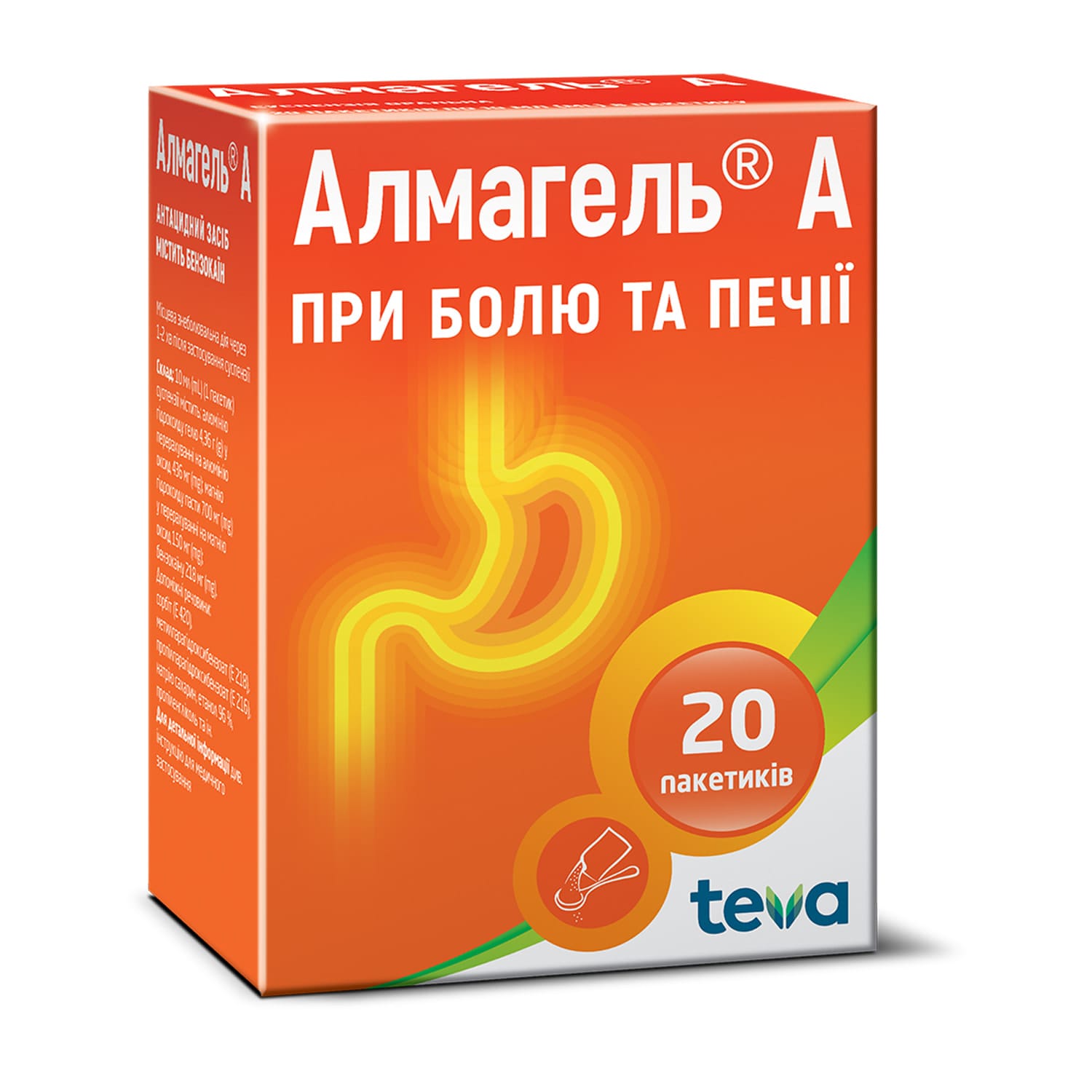
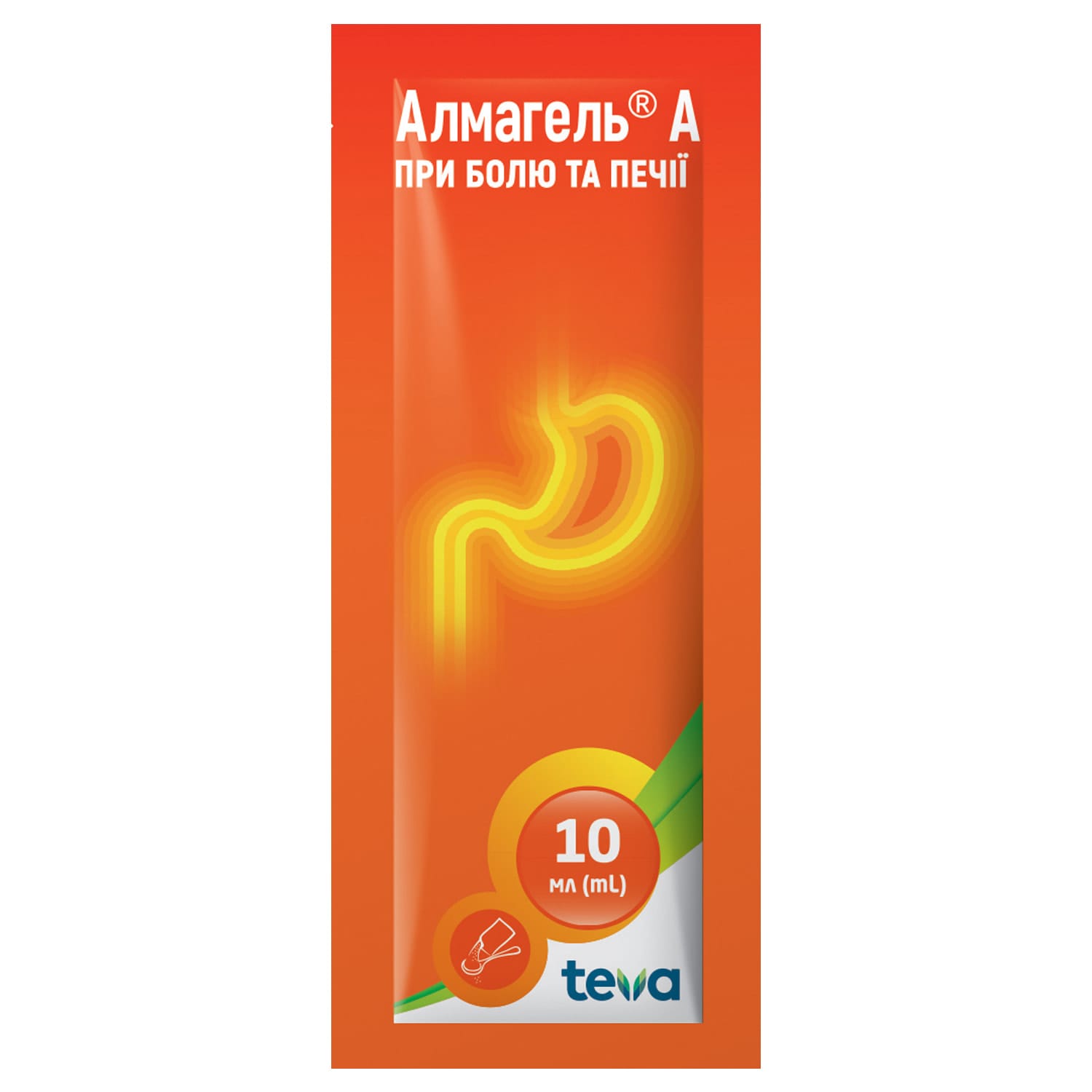
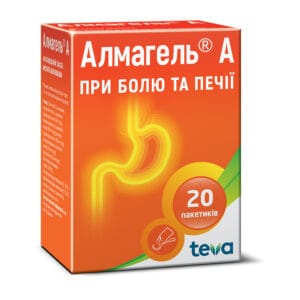


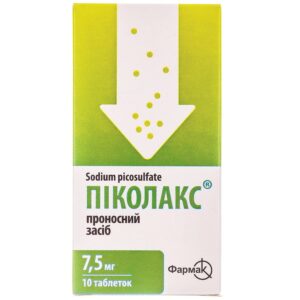
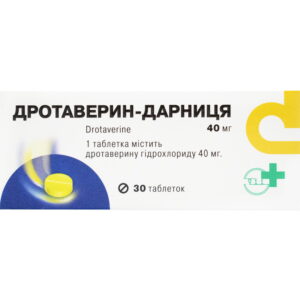
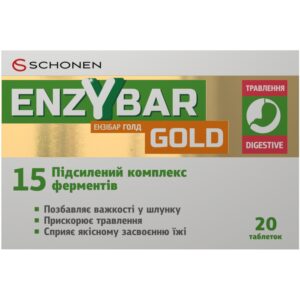
Reviews
There are no reviews yet.